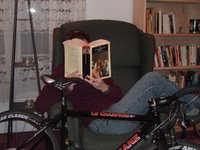A little while back, Stefanie from So Many Books wrote a post on Emerson that included a discussion on thought and action, knowing and doing, how they need each other and feed into each other. She wrote this in the comments to that post:I like Emerson's thought about knowing and doing too. I had a college professor tell me once when she saw I rode a bicycle to school that exercise and action were just as important as reading and thinking. Now I know where she got that from!
It sounds to me like this was a great professor. I can’t say the idea is something I heard much of when I was in school. I had a friend who said once that he wished he could be just a brain, without a body, and I’ve always thought that was sad. Actually, I bet this friend didn’t really, really mean it, that he was just playing around with the idea, or blurting out the feeling of a moment, but still he was expressing some genuine ambivalence about the value of bodily experience.
And it’s a kind of thinking I can be prone to, although I know better at the same time. The value of the body, of action and exercise, is easy to forget when I’m caught up in my mental, intellectual world.
But there are things I’ve learned through action and exercise that I couldn’t have learned in any other way. I’ll tell you one example. I was always terrified of having to do anything that involved going upside down: somersaults, cartwheels, getting lifted by my ankles as a really young kid. I don’t know where this came from, but I dreaded doing “tumbling” units in gym class. I would fake being sick, or pretend to practice my cartwheels when the teacher wasn’t looking. It was one of those phobias I didn’t understand and couldn’t shake. And boy would I dread those times in gym class – in the way of young people, I didn’t have a whole lot of perspective, and those classes were nightmares, inspiring a terror that would begin months before the classes themselves did. One of the best things about graduating from high school was that it meant no one could ever, ever make me go upside down in any way ever again. My head was staying firmly over my feet.
Well, a few years ago I began attending yoga classes, and one of the things we worked on now and then was inversions. Going upside down. These classes were purely optional, no one was making me do anything, and I could sit out the inversions part of the class if I wanted to. But I tried doing a shoulder stand, which didn’t seem all that hard, not really going upside down, and I learned how to do it. Then I got used to doing that pose where you’re lying on your back and you lift your feet up and over your head and rest them back on the floor behind you. That made me very nervous at first, but I got the hang of it.
Then I tried a headstand against the wall. I think it was the yoga class itself that made me willing to try these things – the feeling of openness and acceptance you can get in a good class, where you know that people aren’t judging you, the teacher isn’t judging you (and certainly isn’t grading you), and it felt like a safe space to try things. I learned how to do a headstand.
And then I spent a long time trying to do a handstand, again against the wall. This was the scariest of the all the inversions we tried because at least in a headstand you have your head and your forearms and your hands on the floor, but a handstand is just your hands. And it took me forever to learn. Sometimes my teacher would catch my feet and pull me up into the pose. Finally, I learned the trick of looking at my hands rather than watching my feet as they flew up, and I did it.
So after about 30 years of terror at kicking my feet up into the sky, I learned I could do it. And, of course, I learned things about my limits: that I can do things I’d always thought I couldn’t, that I can overcome fears I’ve had all my life, that, given the right conditions, I can change my habits of thinking and doing. And I couldn’t learn those things in any other way but by the physical practice. My body learned the lesson first, and then taught it to my mind. My mind can now articulate that lesson, but what really matters, I think is the way my body remembers it, and somehow I know it more deeply than I would any other way.
Thursday, May 18, 2006
Thought and action
Posted by
Rebecca H.
at
8:31 AM
![]()
Subscribe to:
Comment Feed (RSS)



|